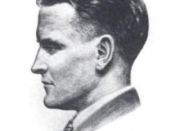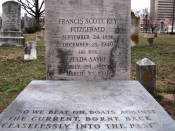The deterioration of the America Dream is a main theme in F. Scott FitzgeraldÃÂs novel, The Great Gatsby. In the novel we gain insight into the life of the upper class during the 1920s through the eyes of Nick Carraway, the novelÃÂs narrator. Through his accounts, we learn how modern times have transformed the notion of the American Dream. This essay will discuss the American Dream and how the character, Jay Gatsby, represents this dream.
In examining the character of Jay Gatsby and how he relates to the American Dream it is important to first understand what the American Dream is. ÃÂThe American Dream is the idea held by many in the United States that through hard work, courage and determination one can achieve prosperityÃÂ (Wikipedia). The American Dream embodies the belief that each person can succeed in life on the basis of his own skills and effort. Originally, the American Dream focused on discovery, individualism, and the pursuit of happiness, but the society of 1920s, as portrayed by Fitzgerald, focuses on the ideas of wealth, success, and status.
Fitzgerald, successfully, portrays the ÃÂdeathÃÂ of the American Dream through the character Jay Gatsby.
For Gatsby, the American Dream is his love for Daisy Buchanan. He identifies Daisy as a rich, beautiful and charming young lady, who represents the perfect woman. This inspires his love and invokes his dream to reach her. ÃÂHe stayed there [St. OlafÃÂs] two weeks, dismayed at its ferocious indifference to the drums of his destiny, to destiny itself, and despising the janitorÃÂs work with which he was to pay his way throughÃÂ (Fitzgerald 105). We see that Gatsby is a poor and uneducated young man, without any past. This is the reason Gatsby becomes interested in the glamour and careless joy that surrounds Daisy. "I was flattered that she wanted to speak to me, because of all the other girls I admired her most" (Fitzgerald 79). ÃÂShe was the first nice girl he had ever known. He found her excitingly desirableÃÂ (Fitzgerald 155). Gatsby questions his ability to reach Daisy, but he remains optimistic and he persists in his relationship.
Gatsby's ambition is a representation of the American Dream as well. He believes that despite his past, he can achieve a relationship with Daisy based on his wealth, his status, and his success. As Brucolli states in his preface, ÃÂHe innocently expects that he can buy anythingÃÂespecially Daisy. She is for sale, but he doesnÃÂt have the right currencyÃÂ (Bruccoli xi). Gatsby goes to extremes in order to gain the wealth that will lure Daisy into his arms. We learn that the origin of GatsbyÃÂs wealth and possessions are questionable. Nick suggests that Gatsby became rich due to illegal activities affiliated with Wolfshiem. Similarly, Tom Buchanan, DaisyÃÂs husband, suggests that Gatsby earned his money through bootlegging. ÃÂHe and this Wolfshiem bought up a lot of side-street drugstores here and in Chicago and sold grain alcohol over the counter. ThatÃÂs one of his little stunts. I picked him for a bootlegger the first time I saw him and I wasnÃÂt far wrongÃÂ (Fitzgerald 141).
Gatsby, also, utilizes his possessions to win DaisyÃÂs affection. This idea is particularly prominent with the lavish parties that Gatsby throws every weekend. ÃÂThere was music from my neighborÃÂs house through the summer nights. In his blue gardens men and girls came and went like months among the whisperings and the champagne and the starsÃÂ (Fitzgerald 43). GatsbyÃÂs ultimate goal in having the parties was to have Daisy attend and become impressed with what he has become. Furthermore, Gatsby utilizes the magnificence of his mansion, the extravagance of his clothing and car. Tom even notices the extravagance, ÃÂIÃÂll take you in this circus wagon [GatsbyÃÂs car]ÃÂ (Fitzgerald 128). Despite GatsbyÃÂs use of wealth and possessions to achieve his dream, his moral status begins to decline.
The American Dream began to fail in GatsbyÃÂs life with the decline of his morals. GatsbyÃÂs character changed once he was reunited with Daisy. His qualities diminished and became more like those of Tom and Daisy. "They were careless people, Tom and DaisyÃÂthey smashed up things and creatures and then retreated back into their money or their vast carelessness or whatever it was that kept them together, and let other people clean up the mess they had made" (Fitzgerald 188). Gatsby becomes dependent on Daisy as she became the central figure of his life. Her qualities and emotions imitated his own. Gatsby stopped thinking about all the other people and was only concerned with Daisy. We see this concern for Daisy after she has killed Myrtle. ÃÂI thought so; I told Daisy I thought so. Its better that the shock should all come at once. She stood it pretty well. He spoke as it DaisyÃÂs reaction was the only think that matteredÃÂ (Fitzgerald 150-51). Although, Daisy was driving GatsbyÃÂs car; he takes the blame in order to protect her. ÃÂWas Daisy driving? Yes, he said after a moment, but of course IÃÂll say I wasÃÂ (Fitzgerald 151). In the end, Gatsby's lack of concern led to his death.
In conclusion, F. Scott FitzgeraldÃÂs novel focuses on the deterioration of the American Dream due to wealth, success, and status. GatsbyÃÂs American Dream was to be in a relationship with Daisy Buchanan. In order to fulfill this dream, he concerned himself with wealth, success, and status to please Daisy. GatsbyÃÂs lack of concern for everything else ultimately led to his downfall and the death of the American Dream.
Works CitedBruccoli, Matthew. The Great Gatsby: Preface. New York: Simon & Schuster, Inc., 1992.
Fitzgerald, F. Scott. The Great Gatsby. New York: Simon & Schuster, Inc., 1925.
Wikipedia. ÃÂAmerican Dream.ÃÂ American Dream ÃÂ Wikipedia. 2005. Wikipedia.
9 June 2005 Works ConsultedUnknown. ÃÂCharacter Analysis - Gatsby.ÃÂ CliffsNotes: The Great Gatsby. 2005. CliffsNotes.
9 June 2005 Unknown. ÃÂThe Great Gatsby Overview.ÃÂ Gatsby Overview. 2000-2005. eNotes.
7 June 2005 Unknown. ÃÂThe Great Gatsby Theme Analysis.ÃÂ The Great Gatsby. 2005. NovelGuide.
7 June 2005





